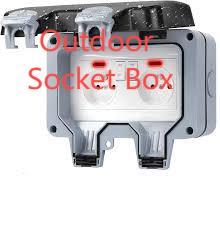When planning exterior electrification, installers often choose an Outdoor Socket Box because it centralizes connections and protects live parts, and designers commonly specify an Outdoor Socket Box in tender documents to ensure consistent protection across exposed locations. This article outlines how product selection, siting, installation, and maintenance practices combine to deliver safe, dependable outdoor power points for homes, commercial sites, and public spaces.
Understanding the need for purpose-built enclosures
Outdoor power demands differ from indoor wiring: exposure to rain, sun, dust, pests, and mechanical contact changes the failure modes installers must anticipate. Purpose-built boxes address these challenges with appropriate ingress protection, robust locking covers, and cable-entry systems that preserve seals even after multiple service visits. Using an outdoor-rated device from the start prevents common field improvisations—like using garden hose covers or temporary adaptors—that create hazards and undermine long-term reliability.
Choosing materials and protection levels carefully
Material selection affects lifespan and performance. UV-stable plastics resist brittleness in sunlight, while powder-coated metals offer superior impact resistance in traffic areas. Specify protective ratings that match the exposure: an IP44 product might suit a sheltered porch, but an IP66 or higher enclosure is better where jets of water, washdowns, or heavy contamination can occur. Consider IK impact ratings in playgrounds or vehicle-access areas, and ask for corrosion-resistant internal components in coastal or chemical-exposed environments.
Siting and mounting best practices
How and where a box is mounted determines its exposure to water ingress and mechanical damage. Mount above likely runoff lines, avoid low points where puddles collect, and provide a small drip overhang or hood to deflect rain. Keep devices away from direct irrigation spray and route conduit so it does not channel water into openings. In public areas, recessing the unit or protecting it with bollards reduces accidental impacts while maintaining user access.
Secure cable entries and strain relief
Cable glands are small but vital components: correctly sized, tightened, and rated glands maintain seal integrity and prevent conductor movement from stressing internal terminations. Use appropriate strain-relief systems and avoid sharp bends at the entry point. Conduits should be supported and routed to avoid movement that could fatigue connections. Where cables are exposed to foot traffic, use armored conduit or protective trays to minimize abrasion and the risk of vandalism.
User access, vandal-resistance, and ergonomics
Public-facing installations require a balance between accessibility and protection. Lockable covers and tamper-resistant fasteners deter misuse, while clear labeling and simple user instructions reduce incorrect operation. For residential sites, easy-open shutters with drip lips help homeowners use outlets safely without exposing contacts to the elements. Ergonomic placement—convenient height and unobstructed approach—reduces strain and lowers the likelihood of accidental damage.
Electrical safety and protective devices
Specifying appropriate overcurrent protection and residual-current devices is essential. Outlets serving outdoor equipment may need additional surge protection or isolating switches. Ensure that earthing and bonding are correctly installed to protect users and equipment from faults. For circuits powering appliances exposed to moisture, place RCD protection near the source and document the protection scheme in handover materials.
Testing, commissioning, and handover documentation
Commissioning proves the installation meets design intent. Perform insulation resistance tests, earth continuity checks, and verify terminal torque. Record results and provide as-built documentation: circuit maps, protection device ratings, and spare-part lists equip maintenance teams to respond quickly. A clear handover packet speeds safe operation and reduces the risk of unsafe modifications by untrained personnel.
Routine inspection and preventive maintenance
A maintenance plan extends service life. Visual checks catch gasket compression, corrosion, or damage early; periodic electrical testing reveals rising contact resistance or insulation degradation. Replace worn gaskets before wet seasons and keep a basic field kit of spare glands, fasteners, and seals. Thermal imaging under load identifies hotspots before they cause failure, turning reactive repairs into scheduled maintenance.
Planning for future upgrades and smart features
Allow for expansion by choosing enclosures with spare knockouts or internal space for metering and sensors. Modern sites benefit from modularity: adding monitoring modules or communication devices later is cheaper than replacing entire units. Consider pre-wiring for potential smart functions like remote lock control, energy monitoring, or load-shedding interfaces that support energy management strategies.
Conclusion: durable selection, correct installation, and simple care
A reliable outdoor power point is the result of realistic product selection, careful siting, professional installation, and disciplined maintenance. Prioritize appropriate protection ratings, robust cable entry systems, and service-friendly designs to reduce downtime and safety risk. For compatible models, detailed specifications, and accessory options, visit www.nante.com/product/

